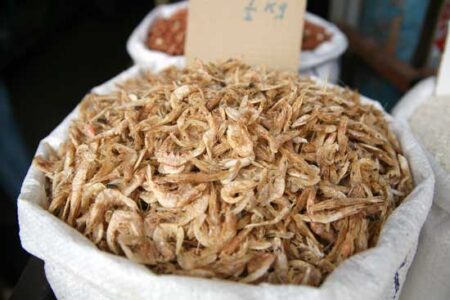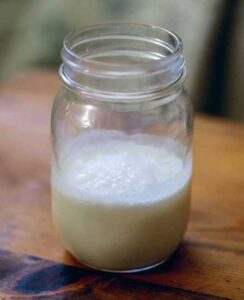GettyImages/elkor
Mashing is the process in which starches are converted to ferment able sugars. Grains are mostly starch, protein and fiber; all grains are roughly so percent starch. For fermentation to work, starches must be broken down into simple sugars to enable the yeast to con sume them. During mashing, the diastatic enzymes activated during malting (see sidebar What Is Malt?) go to work on the starches.
Starches consist of long chains of glucose molecules. These chains can contain as few as 4 and as many as 400 sugar molecules.
{Shorter-chain starches are water-soluble; longer-chain starches are not water soluble.) The glucose chains are connected by ether linkages. An ether linkage happens when two sugar molecules join together and one water molecule is removed. During the process of mashing, enzymes cause water molecules to be reintroduced to the ether linkages, breaking the link, thus freeing the sugars from the chain.
There are two main stages in the process of converting starches to fermentable sugars: liquefaction and saccharification. During liquefaction, the alpha-amylase enzymes convert long-chain in soluble starches to water-soluble short-chain starches. Next, beta amylase enzymes reduce short-chain starches to sugar molecules (saccharification).
Malted grains (usually barley) supply the enzymes needed for starch conversion.
Mash temperatures must be maintained precisely in order to get the maximum levels of fermentable sugars out of the grain without damaging the critical enzymes. The optimum temperature range for alpha-amylase is 67°- 71°C/152 °- 16 0 °F; for beta-amylase, it is 60 °- 66°C/140 °- 151°F.
Water
A topic of much debate among distillers is what kind of water is best. Mashing water should be as nearly devoid of iron as possible. High iron content will destroy the enzymes needed for starch con version. A fairly high calcium content, however, is beneficial to the fermentation process and contributes to the ultimate flavor of the spirit.
If the water is low in calcium and you want to add calcium, use calcium sulphate (gypsum) rather than calcium carbonate {precipi tated chalk).
If you want to have your water tested, the important things to find out are: overall hardness level (ideally hardness level 8 or less), iron content (ideally less than 25 parts per million [ppm]), calcium content and pH.
If you are using distilled or deionized water, adding 2 teaspoons (10 ml) gypsum per 20 liters water will bring the calcium level to about 150 ppm. We are fortunate that our spring-fed water supply is naturally high in calcium and completely free of iron.
pH of the Mash Water
Optimum pH of mash water is 5.2 to 5.5. I find that adding 2½ cups (625 ml) backset to 5 gallons (19 L) of mash water is just right with our spring water, which has a pH of exactly 7.0 (neutral). Alternatively, for instance if I have no backset on hand, I add 2 teaspoons (10 ml) citric acid. Tartaric acid may also be used. Some books sug gest using 95% sulphuric acid to increase acidity, but it can be dan gerous to handle. If you make wine at home, you probably already have some citric acid and/or tartaric acid, so use those to acidify your water.
It’s unusual to need to adjust the water pH upward, that is, in the case of the water being too acidic. Calcium carbonate {precipitated chalk) may be used to make this adjustment when necessary.
Common Grains Used for Small-scale Distilling
Barley
In the last so years, the yields from barley have increased by around 30 percent . Today, about 25 percent of the barley grown worldwide is used for brewing and distilling .
Six-row malt generally has the highest diastatic power, that is, the ability to efficiently convert starches to sugars (see sidebar What Is Malt? ). Because six-row barley kernels are smaller than those of two-row barley, six-row barley has more kernels per kilo; more ker nels means more enzymes. These days, though, modified two-row pale malt is nearly as high in diastatic power as the six-row type.
Pale ale and light lager malts have high diastatic power; they are also usually less expensive than other malt choices. Caramelized and roasted malts retain little of their diastatic power. I have had good consistent results using two-row pale ale malt for just about everything.
By today’s standards, you need roughly 2.2 pounds (1 kg) of malted barley to make one 25-ounce (750-ml) bottle of whiskey at 40%ABV.
Wheat
The alcohol industry uses winter wheat almost exclusively. With a higher starch content, it can produce more alcohol per bushel of grain. Spring wheat is higher in protein so it is better for baking bread . Wheat malt has high diastatic power.
Corn
American commercial distillers use dent corn for making whiskey. Corn gives higher alcohol yield than other cereals due to its higher sugar and starch content; in fact, dent corn typically is 85 percent starch, compared to roughly so percent for barley.
Rye
Always add some rye to bourbon; it contributes a pepperiness and dryness that balance out the sweetness of the corn. Rye can also be grown in colder climates than other cereal grains. It is a winter crop, sown in the fall and harvested early the following summer.
Rye has particularly high levels of a starch group called beta glucan, which is very sticky and gummy. Rye malt also has high dia static power.
Milling
Milling barley increases the surface area of the grain and separates the husk from the interior of the grain, allowing better starch-to sugar conversion rates. Milling malted barley also effectively turns the husks into a natural filtering system that keeps tiny particles from draining out of the wash. When milling malted barley, it is preferable to split the husks rather than crushing them to powder; this creates a better medium for efficient percolation.
Particle size is of critical importance during mashing and fer mentation, and can have a noticeable effect on alcohol yield. For example, in malt whiskey production, the barley is milled to a flaky powder called grist.
More from Craft Distilling
Excerpted with permission from Craft Distilling by Victoria Redhed Miller, Published by New Society Publishers.








